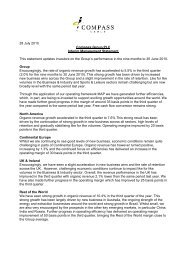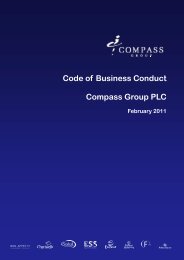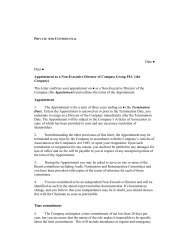10 <strong>Compass</strong> <strong>Group</strong> PLC Annual Report 2007Chief Executive’s statementcontinuedWe are addressing foodcost efficiencies througha systematic approach tomenu planning, purchasingand in-unit processes.Trim Trax – reducing wastageThe ‘Trim Trax’ programme has been developed inthe US Business & Industry sector to help reducein-unit food wastage, focusing on the most frequentreasons we have identified for production loss –overproduction, out-of-date inventory and wastagein the food preparation itself. The programmeprovides some very simple, very visible ways toreinforce the message about reducing waste for ourin-unit teams. One simple, but effective way is givingeach member of the food production team theirown individual ‘Trim Trax’ food waste bin, which hasthe volume recorded, categorised and assigned avalue each day. Results are then tracked, with theteam identifying actions to reduce wastage andrecognition going to the best performers.MAP 3 – Cost of foodWe spend over £3.5 billion ayear on food alone. Our MAP 3objective is to buy the optimalquality and range of food andproducts to meet the needs ofour customers at the lowestcost, whilst having the mostefficient distribution andin-unit production.Managing food cost inflationWe have held our cost of sales flat throughouta year in which we have seen food costinflation affect most food categories in mostof the countries in which we operate. Thedrivers of inflationary pressures stem fromgrowth in demand, such as population andeconomic growth, changes in eating habitsand the increased use of staple crops forbio-fuels, combined with pressure on thesupply side brought about by reducedharvests, often caused by extreme weather,or the impact of food scares.Our ability to manage these inflationarypressures is a result of:The work we have done to include foodcost indexation in our contracts, givingus the contractual right to review pricingwith our clients;Re-engineering our menus to switch fooditems in response to forecast shortagesand cost increases; andContinuing to drive greater purchasingefficiencies through supplier rationalisationand compliance.Leveraging our scaleOur approach to purchasing reflects the needto have the right supplier relationships andpartnerships in place at a local, regional,national and international level. We nowhave country purchasing teams in place todrive purchasing efficiencies in support ofindividual country business plans. Forexample, in the UK we have a programmecalled ‘85:10:5’, the purpose of which hasbeen to move all of our purchasing spendinto the following categories:85% spend or greater through approvedsuppliers;10% spend or less through suppliers ofunique products or services; and5% spend or less through suppliers whomeet specific, local contract requirements.‘85:10:5’ provides the right levels of controland compliance combined with the flexibilityto meet individual contract or service specificneeds. At the same time we are betterleveraging our purchasing volumes bymoving to a smaller group of suppliers anda narrower product range, as we have donein countries like Germany where we haveconsolidated 80% of our purchasing volumewith 11 suppliers and decreased the numberof products from 40,000 to 7,000.We are also seeing significant benefits incompliance, cost control and forecastingthrough more effective menu planning.In Brazil, for example, our units haveonline access to a centralised menu planningdatabase and have reduced average mealcosts by up to 10%.Reducing in-unit production costsAnother focus area under MAP 3 is reducingthe cost of in-unit meal production. A keycomponent of this is reducing food waste,targeting wastage in the production processitself, overproduction or incorrectly orderedor out-of-date stock. Programmes such as‘Trim Trax’, which has been trialled in theUS Business & Industry and Educationsectors, are providing simple, high impacttools to raise awareness of the issue ofwastage with our in-unit teams and embedthe disciplines necessary to reduce it.Reducing supply chain costsOur newly created European Consolidation Centrein Southern Spain has reduced supply chain costsby having fresh produce delivered directly to thisfacility from our own nominated growers, which wethen quality assure and consolidate for dispatchto our distributors in 12 European countries. Byconsolidating our spend and buying at source wehave significantly improved our buying price, qualityand traceability, reduced distribution costs, andreduced the number of lorries on the road. Wereceived the UK Institute of Grocery Distribution’s2007 Food Industry Award for Supply ChainExcellence in recognition of our fresh producebuying strategy.
11 <strong>Compass</strong> <strong>Group</strong> PLC Annual Report 2007Improving efficiency andcosts in our units is a realopportunity that we arestarting to address.Improving efficiencyGood progress is being made to further reduce costsin the UK business. Unit labour scheduling is nowreceiving intensive focus, following the creation ofa dedicated business efficiency team. This teamis directly supporting our operations in embeddingprocesses and disciplines to more effectivelymanage labour scheduling, temporary labour, themanagement of payroll, sickness and holiday in ourunits and the better usage of reporting tools. Integralto this is the roll-out of a communication and trainingprogramme for all our Unit Managers focusingattention on getting the right people in the rightplace at the right time in order to maximise salesand improve customer service and productivity.MAP 4 – Unit costsMAP 4 focuses on drivingcost efficiencies from our£5.5 billion of unit labour andother in-unit, non-food costs.Improving labour productivityOur objective is always to deliver the rightlevel of service in the most efficient waypossible, by ensuring that we have the rightnumber of trained people, performing theright activities in the right place at the righttime, and have the flexibility to absorbincreases in volume.With the focus on labour productivitythrough MAP we have been deploying toolsand processes across our business to improveour labour optimisation. These are scalableto suit the differing sizes of our operationsand range from simple unit-based labourscheduling tools that track and forecast labourhours against sales, through to intensiveon-site reviews by productivity specialistsin our major sites. These programmes, suchas ‘Performance Plus’ in our US Healthcarebusiness, involve detailed time and motionstudies to analyse labour scheduling andefficiency in all areas of the operation, fromfood production to mapping front of houseservice needs against consumer footfall. Thisgives a clear picture of the optimal labourhour requirements on a unit level, allowing usto adjust rostering and employee hoursaccordingly.With the work that we have been doingin this area we continue to deepen ourunderstanding of the key drivers ofproductivity and how to measure, reportand manage it more effectively.Effectively managing labour andancillary costsThrough MAP we are also exercising bettercontrol over other labour costs such asabsenteeism, overtime and third partyagency spend.We have put in place processes and disciplinesto improve our management of salary andbenefit costs and control labour cost inflation.These include local sector benchmarking,a robust process for managing national orsector wage agreements and reviewingbenefits to ensure that those we provideare competitive with local market practices,are valued by our people and that, wherewe use external providers for benefits suchas health insurance, we are leveraging ourscale effectively.Along with food costs, we are now includinglabour costs as part of our pricing indexationmodels, which drive our pricing strategy,product tariffs and which we use in ourcontract pricing review process.Reducing unit overheadsUnit overheads are all the remaining nonfoodand non-labour costs associated withmanaging our units such as uniforms, linen,crockery, laundry/cleaning, utilities andoccupancy costs where we have them.Through good local initiatives and morethorough analysis and measurement wehave made solid progress in the last year,resulting in a reduction in unit overheadsas a percentage of revenue, which we aimto continue.Effective labour cost managementBased on the work done in Australia we havedeveloped tools which are now being used as aglobal template to more effectively measure andcost labour turnover and the use of agency staff at acountry and operating unit level, identifying previoushidden labour costs. In Australia we have seen a1.6% reduction in direct labour costs as a result ofaccurate KPI measurement and the implementationof tailored retention strategies, improved absencemanagement and reduction in agency spend.








